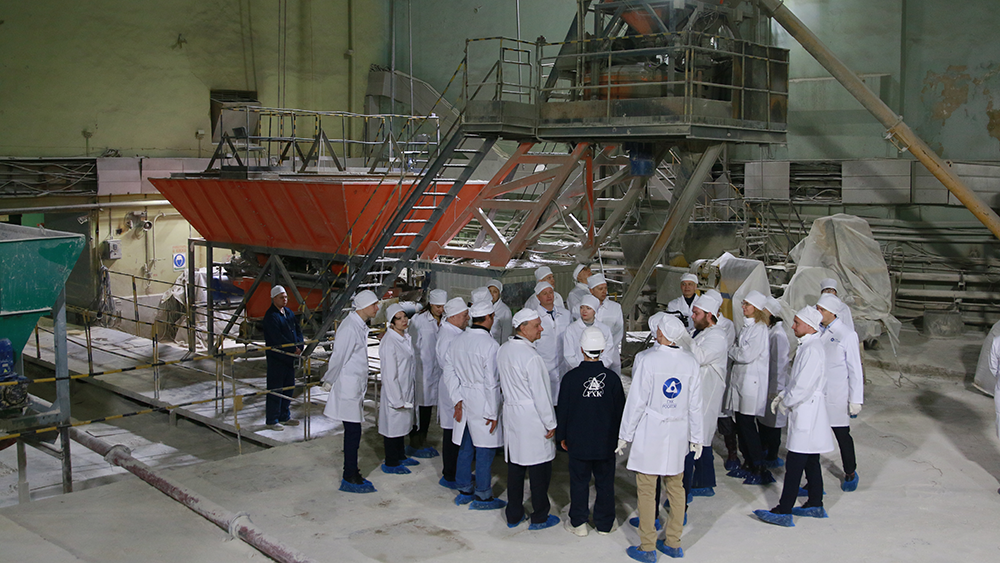 At Russia’s Mining & Chemical Combine (MCC) in Zheleznogorsk (Krasnoyarsk) the decommissioning of two legacy industrial uranium-graphite reactors, AD and ADE-1, is nearing completion. Work on the third one, ADE-2, is underway, but with a difference. It will become the main exhibit of the ADE-2 museum. The ceremony, marking the decision to establish the museum took place in 2021. The AD series reactors, designed by OKBM, are water-cooled uranium-graphite thermal neutron reactors built for the production of weapons-grade plutonium. Three more (ADE-3, 4 & 5), which were subsequently built at the Siberian Chemical Combine in Seversk, are also being decommissioned.
At Russia’s Mining & Chemical Combine (MCC) in Zheleznogorsk (Krasnoyarsk) the decommissioning of two legacy industrial uranium-graphite reactors, AD and ADE-1, is nearing completion. Work on the third one, ADE-2, is underway, but with a difference. It will become the main exhibit of the ADE-2 museum. The ceremony, marking the decision to establish the museum took place in 2021. The AD series reactors, designed by OKBM, are water-cooled uranium-graphite thermal neutron reactors built for the production of weapons-grade plutonium. Three more (ADE-3, 4 & 5), which were subsequently built at the Siberian Chemical Combine in Seversk, are also being decommissioned.
ADE-2 was the last of Russia’s dual purpose plutonium production reactors to be closed. It was shut down in 2010, after producing weapons-grade plutonium for nearly 52 years, in line with the 1997 Plutonium Production Reactor Agreement with the US. It also provided heat and electricity to Zheleznogorsk and nearby areas, which was its main function after 1993. It continued to produce weapons-grade plutonium as a by-product, but under the terms of the US agreement, this could not be used for weapons purposes and was stockpiled.
The first AD reactor was launched in 1958 at MCC, solely for plutonium production. The second, ADE-1, launched in 1961, was intended also to produce electricity (hence the “E” for energy in its name) but never did so as the combined heat and power plant (CHPP) had not been completed. ADE-2 began operation in December 1963 after the CHPP was in place. All three reactors were built underground and used cooling water from the Yenisei River.
It was a huge undertaking. Some 27,000 prisoners worked on the construction of underground reactors. The volume of rock removed was several million cubic metres. More than 1 million cubic metres of concrete were laid, and tens of thousands of tons of metal structures, pipelines, cables were put in place. In the underground rooms, giant fans were installed with a capacity of about 1 million m3 of air per hour.
MCC has been key to the development of new technologies and equipment for the liquidation of the nuclear legacy. Practical work began there in 2015 with the concreting of AD, and in 2020, concreting work began on ADE-1. Decommissioning includes the construction of the necessary infrastructure facilities, the extraction and processing of radioactive waste (RW), and the establishment of safety barriers around the underground part of the reactor, namely localisation of the graphite stack.
The process involves laying a barrier of 8,700 cubic metres of concrete and 37,430 cubic metres of clay material in each reactor. Additional security barriers are also put in place and there is also natural protection in a reliable rock mass as they were built underground. The reactors are located in the foothills of the plant. The volume of waste from dismantling is minimal, which means that there is no need to build new RW storage facilities, which would incur additional costs. This technology was patented by MCC specialists in 2010. By contrast, decommissioning of the reactors at SCC presented more complex waste disposal problems since they were not built underground.
“In world practice, similar facilities are often mothballed or, in extreme cases, cemented, which just postpones the final solution of the problem,” said Victoria Krupskaya, a leading researcher at the Institute of Geology of Ore Deposits, Petrography, Mineralogy & Geochemistry, part of the Russian Academy of Sciences. “But cement alone does not compare with our unique practice of using long-lived clay materials, which ensures all the safety requirements for the disposal of these objects.”
There were a lot of difficulties during decommissioning. Putting in place the barrier mixture and controlling void-free filling required penetrating complex reactor structures. This required a device for remote cutting of metal structures, pipelines, nozzles for filling areas and equipment for quality control of the filling. Most of these tools were developed and implemented by MCC specialists, who have several patents for their inventions. For development of the decommissioning technology, the MCC also received many awards both at international and all-Russian competitions and exhibitions.
“Ahead of us is no less important work including the decommissioning of ADE-2 and the radioactive waste storage pool, as well as radiochemical production,” said MCC Director General Dmitry Kolupaev. “This, in turn, will allow us to develop new areas of activity using the vacated areas, in particular, the construction of a molten-salt reactor. All of our accumulated experience must also be made available, first of all, for the National Operator for Radioactive Waste Management, to use it at other facilities, including those abroad.”
As part of the implementation of the concept of a closed nuclear fuel cycle planned at MCC by 2031, a small-capacity molten-salt research reactor will be built. It will develop technologies for burning long-lived nuclear waste such as minor actinides, which is an important task for the industry from an environmental point of view.
Image courtesy of Rosatom



